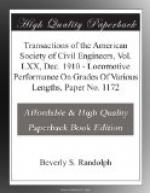“(3) The presence of creosote will not weaken wood of itself. Since apparently it is present only in the openings of the cells, and does not get into the cell walls, its action can only be to retard the seasoning of the wood.” [Tables 3, 4, 5, and 6.]
[Illustration: Fig. 7.—DEFLECTON curves beam VII]
COMPARISONS.
A comparison of the results obtained with tests made on untreated timber is interesting, and to this end Tables 2 and 3, from Circular 115, Forest Service, U. S. Department of Agriculture, by W. Kendrick Hatt, Assoc. M. Am. Soc. C. E., are quoted. The tests made by the writer were from timber raised in Louisiana and Mississippi, while the tests quoted were from timber raised farther north. The number of tests was not sufficient to settle questions of average strength or other qualities. It will be seen, however, that the treated timber 26 years old compares favorably with the new untreated timber.
[Illustration: Plate I, Fig. 1.——Specimen in testing machine, showing method of support.]
[Illustration: Plate I, Fig. 2.—End views of tested timbers.]
TABLE 2.—BENDING STRENGTH OF LARGE STICKS.
Columns in table:
A: Reference number.
B: Number of tests.
C: Moisture, per cent.
D: Rings per inch.
E: Specific gravity, dry.
F: Weight per cubic foot,
in pounds.
G: As tested.
H: Oven dry.
I: Fiber stress at elastic limit, in pounds per
square inch.
J: Modulus of rupture, in pounds per square inch.
K: Modulus of elasticity, in thousands of pounds
per square inch.
L: Elastic resilience, in inch pounds per cubic
inch.
M: Number failing by longitudinal shear.
Loblolly pine.
+======================================================
==================+ | | Locality| dimensions. | | | | | | | | | of +--------------+ Grade. |Condition | | | | | | A | Growth. |Section,|Span,| | of | | B | C | D | | | | in | in | |seasoning.| | | | | | | | inches.|feet | | | | | | | +---+---------+--------+-----+---------+----------+-------+-
--+-----+----+ | | | 6 by 7| | | | | | | | | | | 6 by 10| 10 | | | | | | | | 1 |South | 4 by 12| to | Square | Green |Average| | 48.0| 5.7| | |Carolina.| 6 by 16| 15.5| edge | |Maximum| 42| 92.1|11.7| | | | 8 by 14| | | |Minimum| | 30.2| 2.3|




